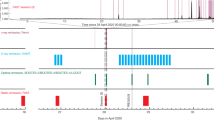Abstract
Important insight into the nature of γ-ray bursts (GRBs) has been gained in recent months mainly due to the immediate, precise localization of the bursts1,2,3 and the discovery of relatively long-lived X-ray afterglows1,2,3,4 by the satellite BeppoSAX5. These advances have enabled deep searches which have led to the discovery of optical transients6,7 coincident with fading X-ray sources. Optical spectroscopy of the latest burst (GRB970508; ref. 8) has clearly demonstrated that it lies at a cosmological distance, thus resolving a long-standing controversy about the distance scale to GRBs. Here we report a variable radio source within the error box of GRB970508 and coincident with the optical transient. We suggest that this is the much-sought-after radio counterpart of a GRB. If the observed fluctuations in the radio emission (‘twinkling’) are a result of a strong scattering by the irregularities in the ionized Galactic interstellar gas, then the source must have an angular size of about 3 microarcseconds in the first few weeks. The damping of the fluctuations with time indicates that the source expands to a significantly larger size later on.
This is a preview of subscription content, access via your institution
Access options
Subscribe to this journal
Receive 51 print issues and online access
$199.00 per year
only $3.90 per issue
Buy this article
- Purchase on Springer Link
- Instant access to full article PDF
Prices may be subject to local taxes which are calculated during checkout

Similar content being viewed by others
References
Costa, E. et al. Discovery of an X-ray afterglow associated with the γ-ray burst of 28 February 1997. Nature 387, 783–785 (1997).
Costa, E. et al. IAU Circ. No. 6649(1997).
Heise, J. et al. IAU Circ. No. 6654(1997).
Piro, L. et al. IAU Circ. No. 6656(1997).
Boella, G. et al. BeppoSAX, the wideband mission for X-ray astronomy. Astron. Astrophys. Suppl. Ser. 122, 299–307 (1997).
van Paradijs, J. et al. Transient optical emission from the error box of the γ-ray burst of 28 February 1997. Nature 386, 686–689 (1997).
Bond, H. E. et al. IAU Circ. No. 6665(1997).
Metzger, M. R. et al. Spectral constraints on the redshift of the optical counterpart to the γ-ray burst of 8 May 1997. Nature 387, 878–880 (1997).
Djorgovski, S. G. et al. The optical counterpart to the γ-ray burst GRB970508. Nature 387, 876–878 (1997).
Windhorst, R. A. et al. Microjansky source counts and spectral indices at 8.44 GHz. Astrophys. J. 405, 498–517 (1993).
Pian, E. et al. Hubble space telescope imaging of the optical counterpart to the gramma-ray burster GRB970508. Astrophys. J. (submitted).
Pooley, G. & Green, D. A. IAU Circ. No. 6670(1997).
Smith, I. A. et al. IAU Circ. No. 6663(1997).
Shepherd, D. S., Metzger, M. R. & Kulkarni, S. R. IAU Circ. No. 6664(1997).
Waxman, E. γ-ray burst after-glow: confirming the cosmological fireball model. Nature (submitted).
Mészáros, P. & Rees, M. J. Optical and long wavelength afterglow from gamma-ray bursts. Astrophys. J. 476, 232–237 (1997).
Paczyński, B. & Rhoads, J. E. Radio transients from gamma-ray bursters. Astrophys. J. 418, L5–L8 (1993).
Katz, J. I. Low frequency spectra from gamma-ray bursts. Astrophys. J. 432, L107–L109 (1994).
Wijers, R. A. M. J., Rees, M. J. & Meszaros, P. Shocked by GRB 970228: the afterglow of a cosmological fireball. Mon. Not. R. Astron. Soc. (submitted); Preprint astroph/9704158(1997).
Vietri, M. The afterglow of gamma ray bursts II: the cases of GRB 970228 and GRB 970508. Astrophys. J. (submitted).
Goodman, J. Radio scintillation of gamma-ray burst afterglows. Preprint astro-ph/9706084 (1997).
Narayan, R. in Pulsars as Physics Laboratories(eds Blandford, R. D., Hewish, A., Lyne, A. G.&Mestel, L.) 151–165 (Oxford Univ. Press, (1993).
Taylor, G. B., Frail, D. A., Beasley, A. J. & Kulkarni, S. R. Position and parallax of the γ-ray burst of 8 May 1997. Nature 389, 263–265 (1997).
Katz, J. I. & Piran, T. Persistent counterparts ot GRBs. Preprint astro-ph/9706141 (1997).
Acknowledgements
The VLA is a facility of the NSF operated under cooperative agreement by Associated Universities, Inc. D.A.F. and S.R.K. thank NRAO, and in particular B. Clark and M. Goss, for their support of the GRB programme. We thank R. Blandford and E. Waxman for discussions. S.R.K. is supported by the NSF and NASA.
Author information
Authors and Affiliations
Corresponding author
Rights and permissions
About this article
Cite this article
Frail, D., Kulkarni, S., Nicastro, L. et al. The radio afterglow from the γ-ray burst of 8 May 1997. Nature 389, 261–263 (1997). https://doi.org/10.1038/38451
Received:
Accepted:
Issue Date:
DOI: https://doi.org/10.1038/38451
This article is cited by
-
The scientific performance of the microchannel X-ray telescope on board the SVOM mission
Experimental Astronomy (2023)
-
Line-of-shower trigger method to lower energy threshold for GRB detection using LHAASO-WCDA
Radiation Detection Technology and Methods (2021)
-
Neutron star mergers and how to study them
Living Reviews in Relativity (2020)
-
The key role of BeppoSAX in the GRB history
Rendiconti Lincei. Scienze Fisiche e Naturali (2019)
-
Radio Afterglows of Gamma Ray Bursts
Journal of Astrophysics and Astronomy (2017)
Comments
By submitting a comment you agree to abide by our Terms and Community Guidelines. If you find something abusive or that does not comply with our terms or guidelines please flag it as inappropriate.



